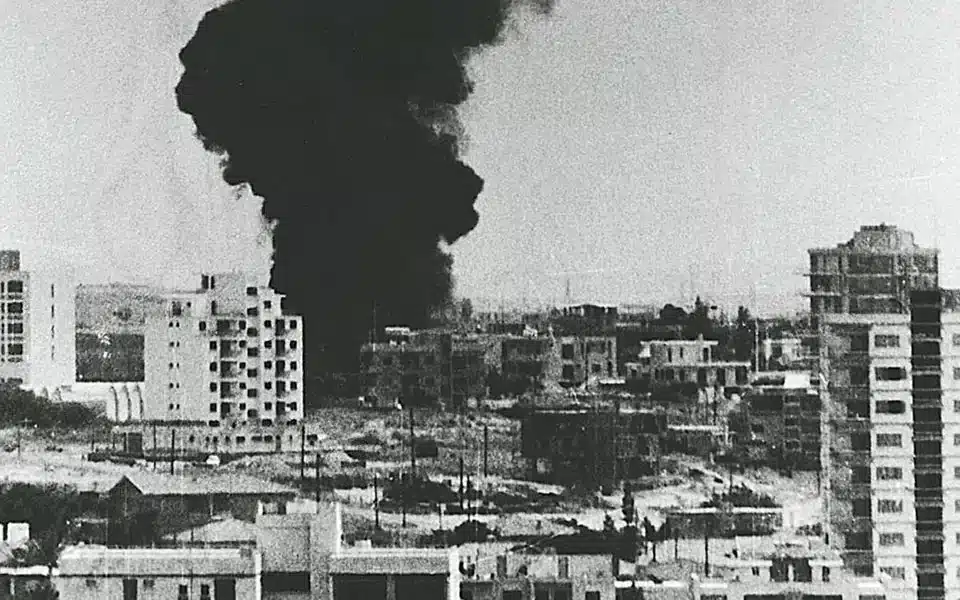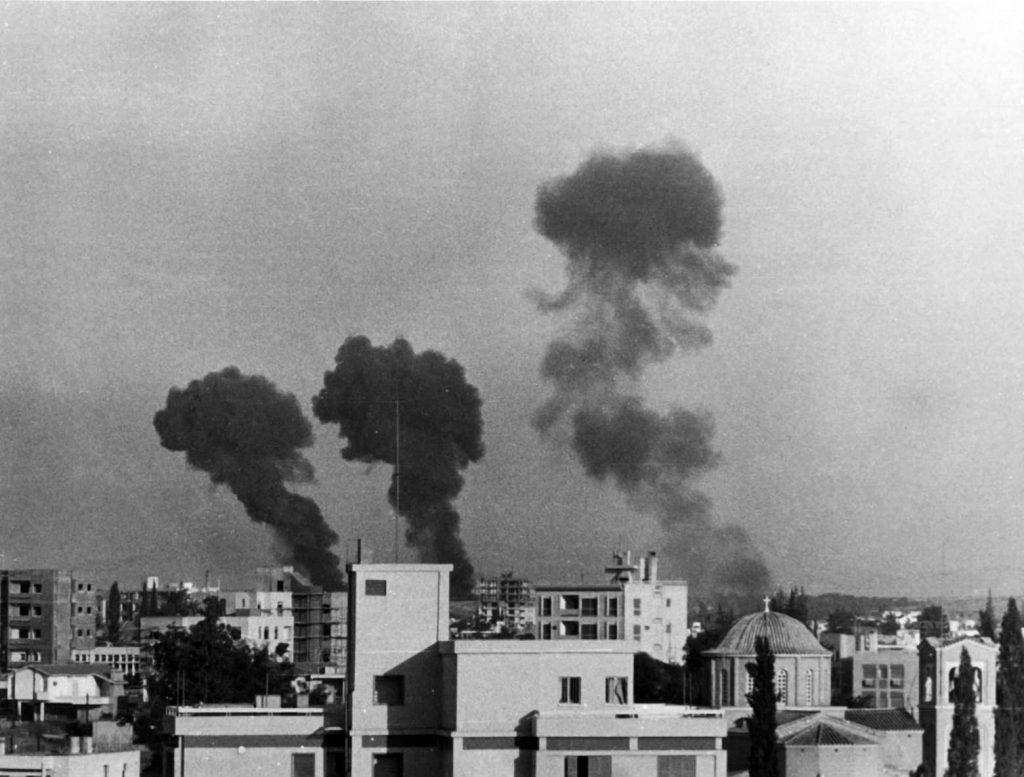The causes of the fall of Famagusta on August 15, 1974 are always a field of discussion, when the city comes to the fore of current events. By studying the literature and talking to the last defenders of the city one understands the real circumstances that finally brought about its capture by Attila.
Tribute to SIMERIN / Andreas Pogiatzis
Of course, there are also those who, easily and painlessly, in an enlightened style, 48 years later, draw the provocative conclusion that the people of Famagusta "ran and left their city without a fight". This oversimplified view ignores, of course, a series of other decisive events, some of them outside the administrative boundaries of Famagusta.

The safety of the city…
The population of Famagusta in 1973 numbered around 43 thousand permanent residents, with 3 thousand of them constituting the urban population. The people of Famagusta were mainly employed in the services and trade sectors, which led the city to an unprecedented, by the standards of the time, development.
For the National Guard, there were two plans concerning Famagusta that would be activated in the event of a crisis. This is the Cyprus Defense Plan (CDP) "Aphrodite", which provided for the repulsion of Turkish aeronautical offensive action and the repulsion of the main attempt by the Turks to land in the bay of Famagusta, a plan which, however, also applied to the bays of Kyrenia and Morphou.
The second plan concerned the Turkish Cypriot enclaves. The Internal Security Plan "Efaistos" provided for the National Guard to take the initiative to neutralize the armed Turkish Cypriot groups.
In addition to this, the units with Famagusta as their area of responsibility were the 336th Battalion of the National Guard, which constituted the main and largest force of the city. The 336 T/E, manned by over 900 reservists and officers, under normal circumstances would have been the main deterrent to the Turkish offensive in Famagusta.
In the city of Famagusta, the 201st Infantry Battalion, based at the school of Agios Loukas, also operated. The 201st consisted of the 173rd Artillery Squadron, a UK Company and the Command Company, with a strength of over 300 men. The area of responsibility of the Battalion was the area west of the walls of Famagusta, the beaches and the Port of the city.
The southern sector of the new city of Famagusta was the responsibility of the 341st Expeditionary Battalion. The Battalion had 3 T-34 tanks and 6 6-pounder guns and, during the invasion, was reinforced with other units retreating to the south and Larnaca.
The Force of the 1st Higher Tactical Command also operated in the city, with a Command Platoon, which consisted mainly of reservists and made up the Famagusta Garrison with Colonel Konstantinos Zarkadas as Commander. The headquarters of the 1st ATD was opposite the walls of the old city, in the western direction.
These were the main forces that would be called upon to implement the GEEF plans in the event of a Turkish invasion.

The start of the invasion
On the evening of July 19th to 20th, and after the mobilization ordered by the Greek Army, the units of Famagusta came out of their camps and deployed to the designated points, to protect themselves from the Turkish bombardments.
In the early hours of the 21st, the 2nd Company of the 336 T/E was ordered to occupy the Turkish Cypriot Sakaria district of Famagusta, but, when the attack occurred, the T/k had already evacuated the district and entrenched themselves in the walled city of old Famagusta.
The T/k retreated to the city walls, after the attack of the 341 T/E, which occupied important positions previously held by the armed groups of the T/k.
Indicative of the situation that prevailed in the city is the narration of the events, by the lawyer and then reserve Second Lieutenant in the Command Platoon of the 1st ATD, Panos Ioannidis: "The Turkish machine gun was captured, the Turks were surprised by the attack and, retreating inside the Walls, they broadcast the panic in the entire -for years- Turkish-occupied old city of Famagusta.
"The reservists asked for reinforcements, explaining to Commander Zarkadas that "the gates are open, the panic among the Turks is widespread and - with a few more fighters - the operation to occupy inside the Walls of Famagusta will be victorious".
"The reservists also explained to the Commander that, "if the old city is captured and the Turks are now among us, the risk of a bombardment of Famagusta is removed, without excluding the possibility that the invaders will no longer consider Famagusta as a priority target".
"The reservists explained this to Colonel Zarkadas, in order to receive the most treacherous order ever heard from a Greek Officer:
""Immediate retreat, the occupation of old Famagusta is not your business..."".
In the meantime, the 2nd Company of 336 T/E was ordered to rejoin the rest of the Battalion, which on the evening of the 21st was ordered to move towards Nicosia. Thus, the occupation of the enclave in Famagusta was never achieved and the Units that remained in the city moved from the attack to the defense.
The 341 T/E, the 201 TP and the 1st ATD, now defended and under heavy bombardment by the Turkish Air Force, retreated, unable to act as they should, in the Forest of Courts and the surrounding buildings.
The drama of the remaining forces of the city culminated when the Commander of Zarkadas and his staff, under the pretense that they "had to visit the GEEF", abandoned Famagusta, leaving its defense headless.
As the testimonies of the days reveal, the 2nd phase of the Turkish invasion of Famagusta began in the afternoon of August 13, with heavy Turkish bombardments and the remaining forces in the city trying to defend it.
At the same time, the reports that the Turkish Army was only a few kilometers from the city were increasing, while communication with the GEEF, to send reinforcements, was impossible. The civilian population of Famagusta left the city, in two phases, when the first truce was reached on August 23 and 13, when the Mias Milia defense line in Nicosia was broken.
For many, the breakdown of the defensive line at Mia Milia meant the immediate fall of Famagusta, since the Nicosia - Famagusta road was wide open. Nevertheless, the hostilities in the city continued with the forces of the 341 T/E, the 201 T/P and the 1st ATD, under the fire of the Turkish air force, trying to limit the t/k enclave inside the walls city.
The Deputy Commander of the 341 T/E, Captain Christos Mitsidis, recounts that the forces of the 201 T/P collided with his Battalion, when the Turks occupied the warehouses of the Port. He reveals that his Unit Command did not communicate with him during hostilities. The only order he received from the Commander of 201 T/P, Lt. Col. Marinakis Antonis, was on the evening of the 15th to prepare a disengagement/retreat plan from the city to Deryneia. Captain Mitsidis assured him that if his forces were reinforced with one more Battalion, from those retreating from other areas, he could hold the area from the walls to the British Bases.
The order, however, was non-negotiable, unhook and retreat. The small force of the 1st ATD received the same orders. Thus, on the afternoon of the 15th, the last order they received, according to the testimony of reserve Second Lieutenant Panos Ioannidis, was "to collect the armaments - Immediate retreat - We abandon our positions, Famagusta is lost...".
Andreas Morfitis, the then reserve Second Lieutenant of the 201st Division and today the Municipal Councilor of Famagusta, recounts that "the order from the Commander of our Unit was dry, dry and blunt: 'Gather your soldiers and we're leaving.' I didn't even have time to react. Nor did he hear my exhortation to take together the banners from our Unit's camp which was 2-3 kilometers below.
"On that afternoon of August 15, a phalanx of soldiers, reservists, artillery vehicles was crossing the British Bases of Decelia to find shelter in Larnaca."
The tragic ending...
The drama of Famagusta is also revealed in Nicosia. The legendary commander Dimitrios Aleuromageiros of the 336 T/E, from Famagusta, who was called to defend the capital, recounts: "The moments were indeed dramatic, because I found that the announcement in the meantime of the -unarmed- capture of AMMOCHOSTO by the Turks affected negatively the soldiers of the Battalion, the greater percentage of whom were from the city and Province of Famagusta.
"It was a miracle that my Famagusta soldiers, despite the drama of their families in Famagusta, stood there to prevent the Turks from taking Nicosia. And they were falling heroically, here! "...and more honor is due to you, because you knew that the Medes, in the end, would pass"".
The city of Famagusta, despite the generally accepted opinion that it was not in the plans of the Turks, fell victim to a wider arrangement that took place in those days. All reports and testimonies reveal that the orders to withdraw from the city, if issued by sworn high-ranking officers, were nonetheless the result of collusion between the parties involved.
Today, in the Cypriot political turmoil, Famagusta, which is "besieged" by Attila the Third, is waiting for all of us 48 years later to take our responsibilities. The orientation of the National Strategy for Famagusta should have as its central pillar and basic condition, the immediate and unconditional return of the city's legal residents.
Source: SIMERINI / Andreas Pogiatziis
